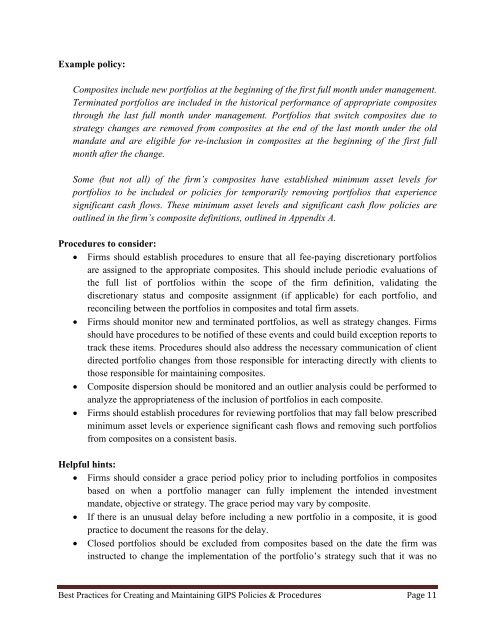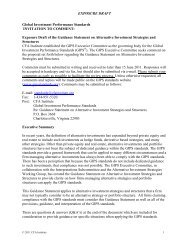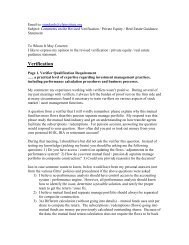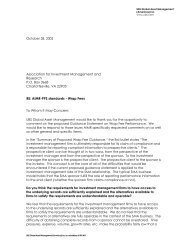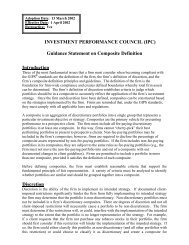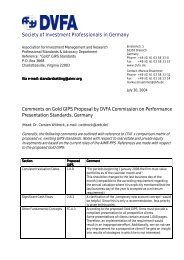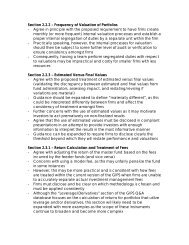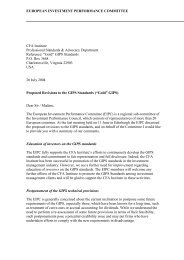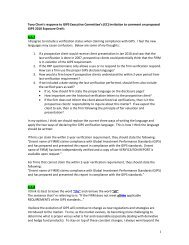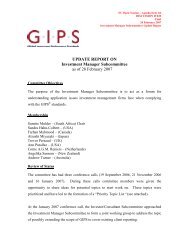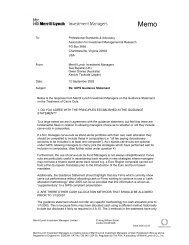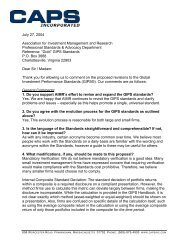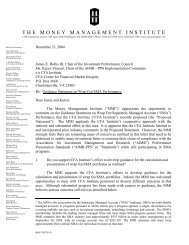Best Practices for Creating and Maintaining Policies and ... - GIPS
Best Practices for Creating and Maintaining Policies and ... - GIPS
Best Practices for Creating and Maintaining Policies and ... - GIPS
You also want an ePaper? Increase the reach of your titles
YUMPU automatically turns print PDFs into web optimized ePapers that Google loves.
Example policy:Composites include new portfolios at the beginning of the first full month under management.Terminated portfolios are included in the historical per<strong>for</strong>mance of appropriate compositesthrough the last full month under management. Portfolios that switch composites due tostrategy changes are removed from composites at the end of the last month under the oldm<strong>and</strong>ate <strong>and</strong> are eligible <strong>for</strong> re-inclusion in composites at the beginning of the first fullmonth after the change.Some (but not all) of the firm’s composites have established minimum asset levels <strong>for</strong>portfolios to be included or policies <strong>for</strong> temporarily removing portfolios that experiencesignificant cash flows. These minimum asset levels <strong>and</strong> significant cash flow policies areoutlined in the firm’s composite definitions, outlined in Appendix A.Procedures to consider:• Firms should establish procedures to ensure that all fee-paying discretionary portfoliosare assigned to the appropriate composites. This should include periodic evaluations ofthe full list of portfolios within the scope of the firm definition, validating thediscretionary status <strong>and</strong> composite assignment (if applicable) <strong>for</strong> each portfolio, <strong>and</strong>reconciling between the portfolios in composites <strong>and</strong> total firm assets.• Firms should monitor new <strong>and</strong> terminated portfolios, as well as strategy changes. Firmsshould have procedures to be notified of these events <strong>and</strong> could build exception reports totrack these items. Procedures should also address the necessary communication of clientdirected portfolio changes from those responsible <strong>for</strong> interacting directly with clients tothose responsible <strong>for</strong> maintaining composites.• Composite dispersion should be monitored <strong>and</strong> an outlier analysis could be per<strong>for</strong>med toanalyze the appropriateness of the inclusion of portfolios in each composite.• Firms should establish procedures <strong>for</strong> reviewing portfolios that may fall below prescribedminimum asset levels or experience significant cash flows <strong>and</strong> removing such portfoliosfrom composites on a consistent basis.Helpful hints:• Firms should consider a grace period policy prior to including portfolios in compositesbased on when a portfolio manager can fully implement the intended investmentm<strong>and</strong>ate, objective or strategy. The grace period may vary by composite.• If there is an unusual delay be<strong>for</strong>e including a new portfolio in a composite, it is goodpractice to document the reasons <strong>for</strong> the delay.• Closed portfolios should be excluded from composites based on the date the firm wasinstructed to change the implementation of the portfolio’s strategy such that it was no<strong>Best</strong> <strong>Practices</strong> <strong>for</strong> <strong>Creating</strong> <strong>and</strong> <strong>Maintaining</strong> <strong>GIPS</strong> <strong>Policies</strong> & Procedures Page 11


